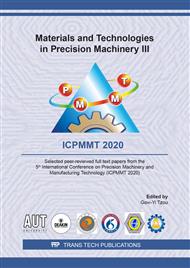p.27
p.33
p.41
p.48
p.56
p.64
p.74
p.80
p.88
Discussion of Scraping Depth and Feeding Rate Performance of Micro Shaping
Abstract:
A novel micromachining technology is investigated in this work. Precision machining of micrometer sizes can be achieved by a tool scraping on CNC machine. The knife for scraping with small knife nose with radius of fifty micrometer can scrape surfaces of designed function by path planning of CNC machine. To investigate performance, micro channels are scraped on workpieces by micro shaping. For tool path planning, feeding rate and scraping depth have significant effect on machining performance and depth-to-width ratio. Poly-methyl methacrylate (PMMA) and aluminum alloy are materials for scraping. From the results of experiments, aluminum alloy has better machining performance and smoother scraping surface than PMMA. Smaller scraping depth would induce better performance and size precision. For feeding rate, 800 mm/min is better for PMMA and 500 mm/min is better for aluminum alloy.
Info:
Periodical:
Pages:
80-87
Citation:
Online since:
October 2020
Authors:
Keywords:
Price:
Сopyright:
© 2020 Trans Tech Publications Ltd. All Rights Reserved
Share:
Citation:


